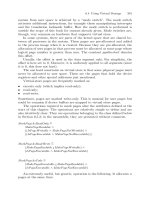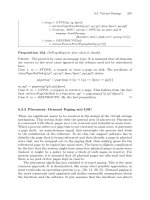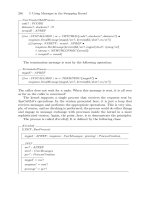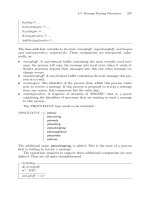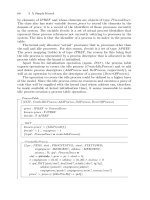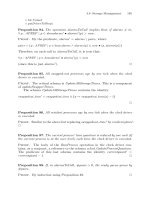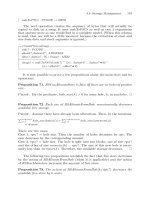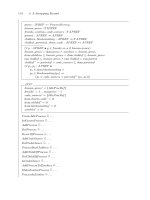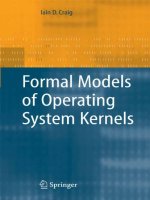Formal Models of Operating System Kernels phần 9 potx
Bạn đang xem bản rút gọn của tài liệu. Xem và tải ngay bản đầy đủ của tài liệu tại đây (292.63 KB, 34 trang )
6.3 Virtual Storage 267
∨ (msg = GTPG p, sg, lpno
∧ retrievePageFromDisk[p/p?, sg/sg?, lpno/lpno?, pg /pg !]
∧ (∃ rpmsg : MSG | rpmsg = ISPG p, sg, lpno, pg •
msgmgr.SendMessage
[fhandler/dest?, pdsk /src?, rpmsg/m?]))
∨ (msg = DELPROCPG p
∧ removeProcessFromPagingDisk[p/p?])))
Proposition 152. OnPageRequest does what it should.
Proof. The proof is by cases on message type. It is assumed that all domains
are correct so the error cases ignored in the schema need not be introduced
here.
Case 1. m = STOPG, a request to store a page on disk. The predicate of
storePageOnDisk[p/p?, sg/sg?, lpno/lpno?, pg /pg ?] states:
pagemap
= pagemap ⊕{p →{sg →{lpno → pg }}}
so pg ?=pagemap
(p)(sg)(lpno).
Case 2. m = GTPG, a request to retrieve a page. This follows from the fact
that retrievePageOnDisk is a function: pg ?=pagemap(p?)(sg?)(lpno?).
Case 3. m = DELPROCPG. By the last proposition. ✷
6.3.2 Placement: Demand Paging and LRU
There are significant issues to be resolved in the design of the virtual storage
mechanism. This section deals with the general area of placement. Placement
isconcernedwithwherepagesaretoberemovedandincludedinmainstore.
When a process refers to a page that is not currently in main store, it generates
a page fault, an asynchronous signal that interrupts the process and leads
to the satisfaction of the reference. To do this, the support software has to
identify the page that is being referenced and then identify a page in physical
store that can be swapped out to the paging disk, thus making space for the
referenced page to be copied into main store. The issue is slightly complicated
by the fact that the system might have some free physical pages in main store
(indeed, it might be a policy to keep a block of such pages in reserve). For
present purposes, it is assumed that all physical pages are allocated and that
there is no pool of free pages kept in reserve.
The placement algorithm just outlined is demand paging.Thisisthemost
common approach. It is documented, like many other possible approaches, in
most textbooks on operating systems (e.g., [26, 11, 29, 5]). Demand paging is
the most commonly used approach and makes reasonable assumptions about
the hardware and the software. It just assumes that the hardware can detect
268 6 Virtual Storage
a page fault and that the software can find the referenced page and locate the
page in main store where it can be stored; if there is no free page, demand
paging assumes that there is a way to find a victim page that can be swapped
out to make space.
ISR
Page
Fault
Handler
Physical
Store
Paging
Disk
Process
Hardware Page
Fault (signal)
process Id
page
request
replacement
page
+ faulting
address
Fig. 6.3. Process organisation for handling page faults.
The placement algorithm used in this model has two identifiable aspects:
1. finding pages to remove;
2. pages to include.
The second aspect is solved for us: the pages to include are always those that
cause a page fault when referenced by a process.
The general organisation of the processes that handle page faults is shown
in Figure 6.3.
6.3.3 On Page Fault
A page fault occurs when a virtual address refers to a page that is not in
physical store.
When such a fault occurs, it is assumed that the address causing the
fault is available to the operating system. From this address, it is assumed
that the following parameters can be computed: segment number, logical page
number and the offset into the logical page. In addition, it is assumed that the
6.3 Virtual Storage 269
identity of the process causing the page fault can be determined (it should be
the currently running process on a uni-processor; in the terms of this book,
the value of currentp).
The case in which a page is shared is identical. The important thing to
remember is that the owning process causes the page fault. If a page is shared,
the important thing is for the page not to be swapped in (or out) more than
once. That is why the smap is included in PageTables. When a shared page is
to be swapped, this map is consulted. If the page is shared, it should already
be in store. Conversely, if a page is to be swapped in, the smap should be
consulted for the same reason.
In this section, a page that is to be removed from main store in order to
free a page frame will be called a victim or candidate. It is always a restriction
on victim page selection that victim pages are never locked into main store.
To define a relatively simple candidate-finding algorithm, it is necessary
to associate page frames in main store with a bit that is set by the hardware
whenever a page is referenced and a counter. The counter is a single byte
whose value is computed by rotating the reference bit into the top bit of the
counter byte and or-ing the counter with the contents of the counter shifted
down one bit (ignoring the bottom bit). The types of the reference bit and
the counter are:
BIT == {0, 1}
N
256
== 0 255
(N
256
is just the naturals 0 2
16
− 1—i.e., a 16-bit unsigned.)
The computation of the counter value forms part of the predicate of schema
ComputeHitCounts. To define a swap-out procedure, it is necessary to extend
PageFrames a little so that information on page usage is represented.
The class and its operations are relatively straightforward.
PageFrames
(INIT , GetPage, OverwritePhysicalPage, ClearRefBitsAndCounter,
ComputeHitCounts, IsVictim, VictimPhysicalPageNo)
frames : PAGEFRAME
refbit : PHYSICALPAGENO → BIT
count : PHYSICALPAGENO → N
256
dom count = dom refbit
dom count ⊆ dom frames
# dom refbit = numrealpages
270 6 Virtual Storage
INIT
(∀ i :1 numrealpages •
frames
(i)=NullPage)
dom refbit
= ∅
dom count
= ∅
GetPage =
OverwritePhysicalPage =
ClearRefBitsAndCounter =
ComputeHitCounts =
IsVictim =
VictimPhysicalPageNo
=
GetPage
pageno?:PHYSICALPAGENO
fr!:PAGE
1 ≤ pageno? ≤ numrealpages
fr!=frames(pageno?)
This operation retrieves a page.
The infix function after is required by the next schema. Its definition is
repeated for convenience:
after :seqX × N → seq X
∀ m :seqX ; offset : N •
dom(m after offset)=(1 #m − offset) ∧
(∀ n : N •
(n + offset) ∈ dom m ⇒ (m after offset)(n)=m(n + offset))
OverwritePhysicalPage
∆(frames)
pageno?:PHYSICALPAGENO
pg ?:PAGE
frames
= frames ⊕{pageno? → pg?}
This operation overwrites a page in main store. The input pageno? is the index
of the page frame in main store and pg ? is a page full of data.
Proposition 153. The predicate of the substitution instance of the predicate
OverwritePhysicalPage[p/pageno?, pg /pg ?] replaces the page indexed by p in
frames by the page, pg and only that page.
6.3 Virtual Storage 271
Proof. The ⊕ operation can be defined as:
(f ⊕ g)(x)=
f (x ), x ∈ dom f
g(x ), otherwise.
Then, for the predicate of the schema:
(frames ⊕{pageno? → pg ?})(x )=
frames(x), x ∈ dom frames
{pageno? → pg ?}, x = pageno?
✷
The clearing of the reference bits and reference counter in a physical page
is defined as follows:
ClearRefBitsAndCounter
∆(refbit, count)
ppno?:PHYSICALPAGENO
refbit
= refbit ⊕{ppno? → 0}
count
= count ⊕{ppno? → 0}
The following operation computes the hit count for each page. That is, it
computes the number of times the page has been referenced since it was copied
into main store. It must be performed on a cyclic basis but this model does
not specify how the cycle is implemented—hardware is the optimal way to
compute such counts because the counter must be updated on each reference.
The computation operation is defined by the following schema:
ComputeHitCounts
∆(pcount, count)
(∀ i : PHYSICALPAGENO | i ∈ dom frames •
(∃ pcount : N
265
•
pcount =(count(i)/2)
mod 256
+ refbit(i) ∗ 2
7
∧
count
= count ⊕{i → pcount}))
The lowest count value is chosen as the victim:
IsVictim
(∃ j : PHYSICALPAGENO | j ∈ dom count •
count(j )=min(ran count))
The physical page of the victim must be obtained:
VictimPhysicalPageNo
victim!:PHYSICALPAGENO
(∃ : PHYSICALPAGENO | i ∈ dom count •
∧ count(i)=min(ran count)
∧ i = victim!)
272 6 Virtual Storage
This algorithm is not foolproof but is a reasonable, hardware-independent
choice. There are many alternative algorithms in the literature (see, for ex-
ample, [26] or [29]) but the best will always be determined by the hardware
on which the operating system runs. The assumption made here is a mini-
mal one (because many processors implement reference bits in page frames);
some machines might provide reference counters directly, while others might
record the time of the last reference to each page. It is to be hoped that,
in the future, victim determination will be considerably simplified by more
co-operative hardware.
The FindVictim operation is “safe” in the sense that it will always find
an in-core page. The reason for this is that the pageout operation defined
aboverequiresthat¬ HaveFreePages be true before FindVictim is called.
This ensures that none of the candidate pages is in freepages.
PGMSG ::= DELPROCPG AREF
| GETPG AREF × SEGMENT × LOGICALPAGENO
| STOPG AREF × SEGMENT × LOGICALPAGENO × PAGE
|
ISPG AREF × SEGMENT × LOGICALPAGENO × PAGE
FMSG ::= BADADDR APREF × SEGMENT × LOGICALPAGENO
The ISR handling page faults can be defined as the following class. It is a
subclass of the message-based ISR defined in the last chapter.
PageFaultISR
(INIT ,
OnPageInterrupt)
GenericMsgISR
sched : LowLevelScheduler
ptab : ProcessTable
INIT
schd?:LowLevelScheduler
pt?:ProcessTable
sched
= schd? ∧ ptab
= pt?
6.3 Virtual Storage 273
OnPageInterrupt
intaddr?:VIRTUALADDRESS
∃ fmsg : FMSG; cp : APREF ; sg : SEGMENT ;
lpno : LOGICALPAGENO; offset : N •
saddrseq(saddresstrans(intaddr?)) = sg
∧ spageno(saddresstrans(intaddr?)) = lpno
∧ sched.CurrentProcess[cp/cp!] ∧ sched.MakeUnready[cp/pid?]
∧ ptab.DescrOfProcess[cp/pid?, pd /pd !]
∧ ctxt.SwapOut ∧ fmsg = BADADDR cp, sg, lpno
∧ (∃ isrid, fdvrid : APREF | fdrvrd = faultdrvr •
SendInterruptMsg[fdrvrid/driver?, fmsg/m?])
o
9
ctxt.SwapIn
When a page fault occurs, the ISR sends a message to the PageFault-
Driver. The page-fault handler or driver is defined by the following class. As
is usual with classes that represent processes, it exports only one operation,
here DoOnPageFault. The driver also contains routines that access page ta-
bles but they are not exported. The idea is that once the driver starts, it has
exclusive access to these data structures. The data structures, however, still
need to be protected by locks.
PageFaultDriver
(INIT , DoOnPageFault)
sched : LowLevelScheduler ; ptab : ProcessTable; pts : PageTables;
vsm : VStoreManager; pfs : PageFrames; msgman : MsgMgr
lck : Lock
INIT
mmgr?:MsgMgr ; sch?:LowLevelScheduler
ptb?:ProcessTable; pgtabs ?:PageTables
vstoreman?:VStoreManager
pgfrms?:PageFrames; lk?:Lock
msgman
= mmgr? ∧ sched
= sch? ∧ ptab
= ptb? ∧ pts
= pgtabs?
vsm
= VStoreManager ∧ pfs
= PageFrames ∧ lck
= lk?
274 6 Virtual Storage
findVictimLogicalPage =
haveVictim =
findVictimPage =
swapPageToDisk =
retrievePageFromDisk =
storePageOnDisk =
genOnPageFault =
onPageFault =
DoOnPageFault =
The driver has to find a victim page to swap out when there is no free
store. The following schema defines this operation. The page to be swapped
out is a logical one at this point. The schema maps the logical page to a
physical page by another operation.
findVictimLogicalPage
p!:APREF
sg!:SEGMENT
lpno!:LOGICALPAGENO
victim!:PHYSICALPAGENO
(∃ p : APREF ; s : SEGMENT; l : LOGICALPAGENO |
p ∈ dom pagetable ∧ sg ∈ dom pagetable(p)
∧ l ∈ dom pagetable(p)(sg) •
pagetable(p)(sg)(l)=victim!
∧ l ∈ lockedpages(p)(sg)
∧ p!=p ∧ sg!=s ∧ lpno!=l)
The schema simplifies to:
p!:APREF
sg!:SEGMENT
lpno!:LOGICALPAGENO
victim!:PHYSICALPAGENO
p! ∈ dom pagetable ∧ sg! ∈ dom pagetable(p!)
∧ lpno! ∈ dom pagetable(p!)(sg!)
∧ pagetable(p!)(sg!)(lpno!) = victim!
∧ lpno!=∈ lockedpages(p!)(sg!)
The following definition is a synonym. It tests the reference count of the
victim physical page.
6.3 Virtual Storage 275
haveVictim
= pfs.IsVictim
The final operation to locate a victim page is the following:
findVictimPage =
pfs.VictimPhysicalPageNo[victim/victim!]
∧ findVictimLogicalPage[victim/victim!]
It is possible to put a few properties of pages on a more formal basis.
Proposition 154. Locked pages can never be victims.
Proof. The predicate of findVictimLogicalPage contains the conjunct l ∈
lockedpages(p)(sg), where l is the logical page number, p the process identifier
and sg the segment. ✷
Proposition 155. Free pages can never be victims.
Proof. Since free pages do not belong to any process (by Proposition 147),
they do not appear in pagetable, so they cannot be victims because the quan-
tifier in findVictimLogicalPage ranges over pagetable. ✷
Proposition 156. Faulting processes are not ready.
Proof. The predicate of PageFaultISR.OnPageInterrupt contains a refer-
ence to the schema MakeUnready[cp/pid?], where cp is the current process
(i.e., cp = currentp), so it is the process that caused the page fault. The action
of MakeUnready is to remove the process from the ready queue. ✷
Proposition 157. A faulting process cannot be executed.
Proof. By the previous proposition, MakeUnready implies that cp cannot
be scheduled until it is returned to the ready queue. Furthermore, cp cannot
continue because OnPageInterrupt calls sched.ScheduleNext to select the next
process to run; this process will not be cp. ✷
Corollary 12. A faulting process is blocked.
Proof. This is a consequence of the previous proposition. ✷
The operation that actually swaps a page from main store to the paging
disk is the following:
276 6 Virtual Storage
swapPageToDisk
=
(findVictimPage[p/p!, sg/sg!, lpno/lpno!]
∧ vsm.MarkSharedLogicalPageAsOut[p/p?, sg/sg?, lpno/lpno?]
∧ pfs.GetPage[pg/fr !, victim!/pageno?]
∧ storePageOnDisk[p/p?, sg/sg?, lpno/lpno?, pg /pg ?]
∧ pfs.ClearRefBitsAndCounter[victim!/ppno?]
∧ storePageOnDisk[p/p?, sg/sg?, lpno/lpno?
, pg /pg ?])
\{pg , p, sg, lpno}
∨ Skip
First, a victim is located and then marked as being not in store (MarkShared-
LogicalPageAsOut). The page causing the page fault is then demanded from
the paging disk and the victim is sent to the disk for temporary storage. The
reference bits of the victim are then cleared so that the referenced page (the
one causing the page fault) can be written to it by storePageOnDisk.
The next operation to be defined is retrievePageFromDisk. This operation,
as its name suggests, communicates with the paging disk process to locate the
page that is to be brought into main store as a consequence of the last page
fault. The reference to this page is, in fact, the one that caused the page fault
that resulted in the current execution of the PageFaultDriver. It is defined by
the following schema:
retrievePageFromDisk
p?:APREF
sg?:SEGMENT
lpno?:LOGICALPAGENO
pg !:PAGE
(∃ msg
o
, msg
r
: PGMSG; src, dest : APREF ; pg : PAGE |
msg
o
= GETPG p?, sg?, lpno?
∧ src = faultdrvr ∧ dest = pagedsk •
msgman.SendMsg[src/src?, dest/dest?, msg
o
/m?]
o
9
(msgman.RcvMsg[src/caller ?, dest/src?, msg
r
/m!]
∧ msg
r
= ISPG p?, sg?, lpno?, pg ! ))
As can be seen, this operation mostly handles messages. First, the operation
sends a message requesting that the paging disk retrieve the page specified by
the parameters p?, sg?andlpno?; the page is represented by pg !. The page,
pg !, is returned by the paging disk in the ISPG message.
The operation to store a page on disk is similar to the last one.
6.3 Virtual Storage 277
storePageOnDisk
p?:APREF
sg?:SEGMENT
lpno?:LOGICALPAGENO
pg ?:PAGE
(∃ msg : PGMSG; src, dest : APREF |
msg = STOPG p?, sg?, lpno?, pg ?
∧ src = faultdrvr ∧ dest = pagedsk •
mgman.SendMsg[src/src?, dest/dest?, msg/m?])
Again, this operation mostly deals with messages. In this case, it contains just
one send operation. Messages of type STOPG request the paging disk to store
the page specified by p?, sg?, lpno?; the page is denoted by pg ?.
The next operation schema defines the operation performed whenever a
page fault occurs. This is a complex operation and its definition reflects this
complexity. The operation receives a message containing a specification of the
page that was referenced and determined (by the hardware) not to be in main
store (it is on the paging disk).
The operation determines whether there are any page frames free in main
store. If there are, the page is located on the disk and copied into a free
page. To do this, the operation sends a message to the paging-disk process
requesting the page.
If there are no page frames free in main store, a page that is currently
resident in main store must be placed on the paging disk in order to make
space for the one that caused the page fault. A suitable resident page must
have a low frequency of reference in the near future and the reference-count
mechanism specified above is used to determine which it is. This page is
referred to as the victim in the following schema and the schemata defining
the selection operations. It should be noted that the victim can belong to any
process whatsoever but cannot be a page that is locked into main store. The
victim is swapped to the paging disk and the one causing the page fault is
retrieved and copied into the newly vacated page frame in main store. The
process that caused the page fault is then returned to the ready queue and
the ISR waits for the next page fault.
It should be noted that the victim can never be a locked page (i.e., a page
locked into main store). This condition is imposed so that, in particular, pages
locked into main store by the kernel (typically pages containing kernel code
and data structures) cannot be swapped out. It is undesirable to swap kernel
pages out of store because they might be involved in the operation currently
being performed or they might be ISRs and the scheduler.
In some kernel designs, it is possible for kernel processes to be stored in
swappable pages. In such a case, the pages would contain data or processes
that are considered to be of lower importance, implementing operations that
the kernel can afford to have blocked while some of their store is paged out.
278 6 Virtual Storage
The kernel assumed here is the one modelled in Chapter 4 and extended
in Chapter 5. It is assumed that all of its components (data structures and
processes) must be stored in pages that are locked into main store (and hence
are stored in pages with the locked attribute). (The schemata defined above
for victim selection, it should be noted, depend on the commutativity of con-
junction.)
genOnPageFault =
∃ fmsg : FMSG; me, src : APREF | me = faultdrvr ∧ src = hardware •
msgman.RcvMessage[me/dest?, src/src?, fmsg/m!]
∧ (∃ fpid : APREF ; fs : SEGMENT ;
flpno : LOGICALPAGENO;
destpg : PHYSICALPAGENO •
fmsg = BADADDR fpid, fs, flpno
((lck.Lock
o
9
((pts.HaveFreePages ∧ pts.Al locateFreePage[destpg/ppno!])
∨ (haveVictim
∧ swapPageToDisk[destpg/victim!])) ∧ lck.Unlock)
o
9
(lck.Lock
o
9
(retrievePageFromDisk[fpid/p?, fs/sg?, flpno/lpno?, page/pg !]
∧ pfs.ClearRefBitsAndCounter[destpg/ppno?]
∧ pfs.OverwritePhysicalPage[page /pg ?, destpg/pageno?]
∧ vsm.MarkSharedLogicalPageAsIn
[fpid/p?, fs/sg?, flpno/lpno?]
∧ lck.Unlock )))
o
9
(lck.Lock ∧ sched .MakeReady[fpid/pid?])
o
9
(sched.ScheduleNext ∧ lck.Unlock))
onPageFault
=(sched.CurrentProcess[p/cp!] ∧ genOnPageFault[p/p?]) \ {p}
DoOnPageFault
=
(∀ i :1 ∞•onPageFault)
Proposition 158. If there are free pages, no page is swapped out.
Proof. The first component of the sequential composition in the predicate
of genOnPageFault contains the disjunction:
(pts.HaveFreePages ∧ pts.Al locateFreePage[destpg/ppno!])
∨ (haveVictim ∧ swapPageToDisk [destpg/victim!])
If there are free pages, pts.HaveFreePages is satisfied. ✷
Proposition 159. If there are no free pages in main store, a page is swapped
out.
6.3 Virtual Storage 279
Proof. There is a disjunction in the composition forming genOnPageFault’s
predicate:
(pts.HaveFreePages ∧ pts.Al locateFreePage[destpg/ppno!])
∨ (haveVictim ∧ swapPageToDisk [destpg/victim!])
In this case, if HaveFreePages is not satisfied, ¬ HaveFreePages must be sat-
isfied and the swap is performed by swapPageToDisk. ✷
Proposition 160. If a process fault occurs, the referenced page overwrites a
page frame freed by swapping out.
Proof. In the previous proposition, the page destpg was swapped out to
disk. In the second component of genOnPageFault’s predicate, the operation
overWritePhysicalPage occurs as a conjunct. By p ∧ q p, the result follows.
✷
Proposition 161. If a process faults, the referenced page is brought into store.
Proof. The operation retrievePageFromDisk[page/pg ] is a conjunct in the
second component of the sequential composition in genOnPageFault. ✷
Proposition 162. If there are free pages, only a free page is written when a
page is swapped in.
Proof. The predicate of schema genOnPageFault contains the following
references:
pts.AllocateFreePage[destpg/ppno!]
o
9
retrievePageFromDisk[ ,page/pg !]
pts.OverwritePhysicalPage[page /pg ?, destpg/pageno?]
The physical page, destpg, is the one overwritten by page in the operation
defined by the schema OverwritePhysicalPage. The physical page destpg is
allocated by AllocateFreePage. The page retrieved from disk is page;itisre-
trieved by retrievePageFromDisk (the omitted arguments refer to the faulting
process). ✷
Proposition 163. Newly swapped pages have a zero reference count.
Proof. Reference bits are cleared in the newly swapped page by genOnPage-
Fault. The second component of this schema’s predicate contains, as one of its
conjuncts, a reference to pfs.ClearRefBitsAndCounter[destpg/ppno?]—this is
a reference to a page frame in physical store, not to the contents (which is
denoted by page in this predicate). ✷
280 6 Virtual Storage
Proposition 164. Newly swapped pages cannot be victims unless all pages
are victims.
Proof. By the victim-finding operation, the victim has the minimum refer-
ence count:
IsVictim
(∃ j : PHYSICALPAGENO | j ∈ dom count •
count(j )=min(ran count))
A newly swapped-in page—one that has not yet been referenced—has a
reference count of 0. To become a victim, there must be no page with reference
count > 0. ✷
A process can be waiting on a device when one of its pages is chosen
to swap out. If the driver copies data and puts it into buffers associated
with the waiting process’ PCBs, there is only the issue of swapping out the
page. However, there is no way a priori of knowing whether the page just
swapped out will cause a page fault when its owning process next executes.
Since swapping out does not affect the operations of the device upon which
the victim is waiting, it would appear valid just to pick any process that is
not locked into main store.
The reader should note that, logically, this is perfectly adequate. As a
proposed implementation, this is unlikely to work well. It is to be expected
that page faults will be relatively frequent. The paging disk has a latency time
that must be taken into account. When a user process causes a page fault,
it must be blocked. Clearly, processes ought to be blocked for the shortest
possible time. The paging disk, however, serialises requests. All of this suggests
that the swapin/swapout operations should be as fast as possible.
Moreover, the specification, as it stands, allows the ISR to respond to as
many interrupts as it can but it must also wait for the driver. The driver’s
message input is restricted to one immediate and one outstanding message.
This suggests that the ISR should enqueue messages on the driver and imme-
diately halt.
Furthermore, the context of the faulting process must be swapped immedi-
ately. This is because it cannot progress and must be taken off the processor:
alternatives are hard to discern. Removal of the current process’ registers from
the processor by the ISR is, therefore, justified.
Similarly, the page disk can lose requests if it just hangs between instruct-
ing a disk search and reading the result.
This subsystem also shows limitations with the message-passing r´egime.
Because a synchronous method has been adopted, the sender must wait if the
receiver is not in a state to receive. This has the implication that, should the
page disk process not be ready to accept another request (either because it is
waiting for the disk or because it is processing another request), the page-fault
6.3 Virtual Storage 281
handler will have to wait. This has the implication that the page-fault handler
might miss an interrupt.
The presence of operations to add and remove process data from the paging
disk complicates matters also. Luckily, these requests will be less common than
simple page faults.
PD
PFH
Dsk
Store
i
s
fault
ok
get
done
ISR
Fig. 6.4. The actual specification.
The question for us is the following. Even though the classes and operations
presented above provide an adequate logical model, they do not take into
consideration all of the pragmatic issues. Should the specification be altered
to reflect these pragmatic issues?
The specification presented above can be represented diagrammatically
as in Figure 6.4. As can be seen, the virtual-storage management subsystem
consists of the ISR (denoted by ISR in the figure), the page-fault driver process
(denoted by PFH in the figure) and the disk driver process (denoted by PD).
The figure also includes the disk itself (denoted by DSK) and main store
(denoted by STORE ).
The arrows in Figure 6.4 denote the messages or interactions between
processes. The arrow labelled i denotes the message sent by the ISR to the
page-fault handling process (PFH ). This message contains the specification
of the page that was referenced (in terms of the segment and logical page
numbers) and the process (its APREF). The page-fault handler sends a fault
message containing the same information to the paging-disk process, which in
turn sends a request (as a get message) to the disk proper (actually, to the
disk driver). The disk driver retrieves the page and sends a done message to
the paging-disk handler. The done message denotes the fact that the retrieval
has been successfully completed.
Once the page has been written to main store, process PD sends an ok
message to the page-fault handler process, PFH . On reception of the ok,the
page-fault handler can wait for another page fault.
282 6 Virtual Storage
It is clearly a highly desirable property for any optimisations of the basic
(logical) specification to behave in the same way as the specification. It is
also highly desirable, given the present context, to be able to demonstrate
this in a formal way. In order to achieve this, the proposed optimisations are
formalised as CCS [21] processes so that they can be manipulated in formally
sound ways. CCS is chosen as the representation because we are interested
in the interactions between the component processes of the subsystem, not
in the specification of the components. The processes to be modelled do not
have properties suggestive of the use of the π-calculus (e.g., mobility), so CCS
appears sufficient.
The subsystem can be represented in CCS as the following set of equations:
ISR =
¯
i.ISR
PFH = i.
fault.ok.PFH
PD = fault.
get.done.¯s.ok.PD
DSK = get.
done.DSK
STORE = s.STORE
The overall arrangement is represented in CCS as:
VM
1
=(ISR | PFH | PD | DSK | STORE) \{i , fault, ok, get, done, s}
(Note that actions are hidden using the \ operation.)
PD
Q
PFH
Dsk
Store
i
s
enq
deq
ok
get
done
ISR
Fig. 6.5. The specification using a queue.
As noted above, the design depicted in Figure 6.4 and represented by the
above set of CCS process definitions can be optimised. An obvious optimisa-
6.3 Virtual Storage 283
tion is to introduce a queue of requests between the page-fault handler (PFH )
and paging-disk process (PD). This is the arrangement shown in Figure 6.5.
In the arrangement shown in Figure 6.5, the PFH process places new requests
into the queue. The queue is represented by the process named Q in the figure,
and the operation of sending a request (really, just an enqueuing of the re-
quest) is represented by the enq arrow. Requests are removed from the queue
process by the paging-disk process, PD, in exactly the same way they are in
the first case. When the page has been copied to main store, the paging-disk
process, PD sends the page-fault handling process an ok to inform it that: (i)
the copy has been performed and that (ii) the process that caused the fault
just rectified can now be unblocked.
The argument is that this second version can process more page faults
per unit time. In this case, PFH does not now wait for the page fault to be
rectified before it can wait for a new fault. Instead, it passes the request to
the rest of the subsystem and then immediately blocks on the page-fault ISR.
This second arrangement can be represented by CCS processes as follows:
VM
2
= init.(ISR | PFH
2
| Q | PD
2
| DSK | STORE)
\{i, enq, deq, ok , done, get, init, s}
For the definition of this subsystem, processes ISR, DSK and STORE remain
as in the first case. The remaining processes must be redefined as follows (the
subscripts will be explained below).
PFH
2
= i.enq.ok.PFH
2
Q = init.enq.Q
1
Q
1
= enq.Q1+deq.Q1
PD
2
= deq.get.done.¯s.ok.PD
2
It is clearly necessary to distinguish between the two versions of PFH that
have been defined at this point (a third version will be added shortly). For
this reason, subscripts were introduced into the specifications.
It would be useful for these two specifications (models) to be equivalent
in some sense. One important sense is that they should be observationally
equivalent; another is that they should be bisimilar.
The property of observational equivalence of two processes is very much the
intuitive one: two processes are observationally equivalent when they cannot
be distinguished by an external observer. In other words, the externally visible
events that can be perceived by an external observer are determined by the
observer to be the same in content and in order, no matter which process is
observed. In the cases of VM
1
and VM
2
, the externally observable events are
restricted by the hiding operator (\,asinZ).
Bisimilarity is an equivalence that also takes hidden actions into account.
(Those readers unfamiliar with the concept should consult [21], Chapter 4,
for an extended treatment.)
It is now possible to engage in formal reasoning about processes VM
1
and VM
2
and to prove two important propositions about them. Rather than
284 6 Virtual Storage
engaging in a hand proof, it was considered interesting to employ automation.
To this end, the Concurrency Workbench of the New Century [8] was employed
as a tool. The Concurrency Workbench can be used to determine a number of
properties of CCS and CSP processes, including observational equivalence and
bisimilarity. The propositions concerning equivalence of the various versions
of the subsystem were all proved using the Concurrency Workbench.
Proposition 165. Processes VM
1
and VM
2
are observationally equivalent.
Proof. Both VM
1
and VM
2
were encoded in the input format required by
the CWB and tested using the eq -S obseq command. The CWB system
determined that VM
1
and VM
2
are observationally equivalent. ✷
Matters are different when it comes to bisimilarity. Processes VM
1
and
VM
2
are quite dissimilar in internal structure, and process VM
2
offers an
initial event, init, which initialises the process Q, so it does not appear, at
first sight, that VM
1
and VM
2
will be bisimilar. Indeed, this is the case.
Proposition 166. Processes VM
1
and VM
2
are not bisimilar.
Proof. Both VM
1
and VM
2
were encoded in the input format required by
the CWB and tested using the eq -S bisim command. The CWB system
determined that VM
1
and VM
2
are not bisimilar. ✷
PD
Q
PFH
PFH
Dsk
Store
i
s
enq
deq
ok
get
done
ISR
Fig. 6.6. The ideal specification.
6.3 Virtual Storage 285
Finally, a second specification can be considered as an optimisation. This
version retains the queue of requests. It differs from the second version by
creating a new instance of the PFH process whenever an interrupt occurs.
This instance performs the same operations as in the second version but im-
mediately terminates (denoted by the 0 process). The CCS specification is
(again, subscripts are used to differentiate between versions):
VM
3
= init.(ISR | PFH
3
| Q | PD
2
| DSK | STORE)
\{i, enq, deq, ok , done, get, init, s}
where:
PFH
3
= i.(enq.ok.0 | PFH
3
)
Proposition 167. VM
3
is observationally equivalent to VM
2
.
Proof. ThemodelsforVM
2
and VM
3
were encoded in the input format re-
quired by the CWB and tested using the eq -S obseq command. The CWB
system determined that the two are observationally equivalent. ✷
Proposition 168. VM
3
is bisimilar to VM
2
.
Proof. ThemodelsforVM
2
and VM
3
were encoded in the input format re-
quired by the CWB and tested using the eq -S obseq command. The CWB
system determined that the two are bisimilar. ✷
From the first of these two results, we have the next proposition:
Proposition 169. Process VM
1
is observationally equivalent to VM
3
.
Proof. By transitivity of the equivalence relation.
(In addition, the encoded models were tested using the eq -S obseq com-
mand and the result was supported by the CWB system.) ✷
We also have the following negative result:
Proposition 170. Processes VM
1
and VM
3
are not bisimilar.
Proof. Again, by transitivity of the equivalence relation, this result would
be expected.
(In addition, the CWB supported the claim.) ✷
The last result is not as bad as it sounds. All that is required, here, is that
the processes appear the same as far as an external observer is concerned.
This property is sufficient for the optimisations to be considered equivalent
to the original. However, as far as this chapter is concerned, the first version
(the one referred to as the “logical” one) is the one that will be adopted.
With this discussion of optimisation out of the way, it is possible to return
to the main theme. There follow some propositions dealing with the properties
of the logical (Z) model of page faults.
286 6 Virtual Storage
Proposition 171. Page faults are serviced in the order in which they occur.
Proof. There are two senses:
1. Each page fault is an interrupt. In this sense, page faults are all processed
in order.
2. In this sense, page faults are serviced by the handler process which services
messages sent to it by the page-fault ISR. These messages are sent in
temporal (sequence) order. That the handler process operates upon these
messages in the correct order is a consequence of the correctness of the
message-passing operations.
Each sense implies the statement of the proposition. ✷
Proposition 172. Every page fault is serviced eventually (i.e., the page-fault
mechanism is fair).
Proof. This proof follows from the correctness and fairness of the message-
passing operations. ✷
Proposition 173. The process causing a page fault has status pstrunning
when the fault occurs.
Proof. Only a running process can cause a page fault.
ISRs cannot cause faults and are not processes.
Drivers are processes. They are locked into main store and, by hypothesis,
have all the necessary pages locked in as well.
Only user processes have pages that can be swapped into and out of store.
The fact that a fault occurs implies that the process causing it is executing.
There can only be one process that is executing at any one time (i.e., is the
current value of currentp and has a status of pstrunnning).
This is a property of the scheduler. ✷
Proposition 174. A faulting process is not unblocked until the replacement
page has been swapped into physical store.
Proof. The service operation onPageFault first blocks the faulting process by
setting its state to pstwaiting and by removing it from the processor. Therefore
blockFaultingProcess implies that currentp = currentp
∧ regs
= regs ,where
regs are hardware registers.
The onPageFault operation takes the form of a sequential composition.
There are three operations, thus forming a composition of the form S
1
o
9
S
2
o
9
S
3
. The second operation is itself a sequential composition; it is this part
that performs the swapping operation. The operations are, therefore, totally
ordered and the order can be directly related to temporal succession.
6.3 Virtual Storage 287
Let p denote the faulting process and let the composition be written as
above. Then post S
1
⇒ status(p)=pstwaiting and currentp
= p.
Throughout S
2
, status(p)=pstwaiting.
Finally, pre S
3
⇒ status(p)=pstwaiting, while post S
3
⇒ status(p)=
pstready but p = currentp—the last being a property of MakeReady. It can-
not be true because the service process is currently executing. ✷
Proposition 175. If a process, p, causes a page fault, that process is not
marked ready until the faulting page has been replaced.
Proof. This follows immediately from the previous proposition. ✷
Proposition 176. After execution of onPageFault, there is exactly one phys-
ical page in physical store such that its logical page number in the faulting
process maps to the physical page number.
Proof. The proposition implies that exactly one page is mapped into store
by the page-fault mechanism.
Inspection of the predicate of genOnPageFault shows that only one page
is introduced into store. ✷
Proposition 177. If a process, p, causes a page fault, after that page fault
has been serviced, the process is in the ready state.
Proof. That the process is blocked follows immediately from Proposition
174. The predicate of genOnPageFault contains an instance of MakeReady
with the faulting process’ identifier substituted for the formal parameter. ✷
Proposition 178. If a page fault occurs and a page has to be swapped out,
that page can be a page belonging to the faulting process or to another process.
Proof. There are two cases to consider.
Case 1: If there are free pages, they are consumed. Only the faulting process
is affected.
Case 2: HaveVictim is called. The victim page is found in physical store by
pfs.IsVictim:
findVictimPage =
pfs.VictimPhysicalPageNo
∧ findVictimLogicalPage
The value returned by pfs.VictimPhysicalPageNo is just a physical page
number with the minimum reference count. The schema does not mention
processes. Similarly, findVictimLogicalPage in this class merely looks up the
288 6 Virtual Storage
owning process’ identifier and the segment in which the page occurs, as well
as the logical page number of the victim page. Therefore, the page can belong
to any process in the system except those that lock it into main store (i.e.,
driver and system processes). ✷
Proposition 179. If a page fault occurs and there are free pages in physical
store, physical store is updated; only one process is affected.
Proof. By the definition of onPageFault:
pts.HaveFreePages ∧ pts.Al locateFreePages
implies that the physical page to which the swapped-in page is to be written
is a free page in physical store.
In this case, only the faulting process is affected. This is because the allo-
cation of a free page relates only to a single process (the process to which the
allocation is made). ✷
Corollary 13. If a page fault occurs within process, p, and if a page has to
be swapped out, only a maximum of two processes are affected by the page-
swapping operation.
Proof. Immediate from the two preceding propositions. ✷
Proposition 180. No pages are swapped unless a page fault occurs.
Proof. Inspection reveals that only the schema genOnPageFault references
the relevant operations. ✷
6.3.4 Extending Process Storage
Processes very often make requests to increase the amount of store they use.
In a paged system, this allocates more pages to the process. This subsection
contains a model of the operations. It is rarer for processes to release store but
operations to perform this task are defined as well. Pages can also be shared
between processes. Sharing can be used, for example, to implement message
passing in virtual storage.
First, there is a problem with allocating pages. The problem is that there
might not be a physical page free when the request is made. The system could
block the requesting process until there is a free page in the page frame. This
solution does not fit well with the aims of virtual storage. Furthermore, when
a new process is created, it will request a set of pages to hold code, data, stack,
6.3 Virtual Storage 289
etc. It would not be acceptable to block the creation of the process until main
store becomes free.
A solution more in keeping with the purpose of virtual store is the fol-
lowing. When a request is made to allocate a new page and there is no free
physical store, an empty page is allocated on disk. The new page is allocated
to the requesting process and can be written to by the requesting process.
This mechanism can be used when allocating extra pages to a new page.
Therefore, it is necessary to begin with the definition of the empty page:
pageofzeroes : PAGE
∀ pg : PAGE •
pageofzeroes = λ i :1 framesize • 0
This structure need not be held in a page; it can be produced in a loop and
then set into a buffer of smaller size. Ideally, it should be packed into a single
disk block and then handed to the paging disk. This needs to be iterated n
times, where n is the number of disk blocks per page.
Pages must be specified when allocating, deallocating and sharing. A
method for specifying them is required. Here, we define a structure for this
purpose:
PAGESPEC == APREF × SEGMENT × LOGICALPAGENO
The following axiomatic definitions are required to manipulate objects of type
PAGESPEC. The relation that comes first will be discussed below. The rest
of the definitions are: the constructor function (mkpgspec) and the accessor
functions (pgspecpref to obtain the process reference, pgspecseg to obtain the
segment name and pgspeclpno to obtain the logical page number).
smap : PAGESPEC ↔ PAGESPEC
mkpgspec : APREF × SEGMENT × LOGICALPAGENO → PAGESPEC
pgspecpref : PAGESPEC → APREF
pgspecseg : PAGESPEC → SEGMENT
pgspeclpno : PAGESPEC → LOGICALPAGENO
∀ p : APREF ; sg : SEGMENT; lpno : LOGICALPAGENO •
mkpgspec(p, sg, lpno)=(p, sg, lpno)
∀ ps : PAGESPEC •
pgspecpref (ps)=fst ps
pgspecseg(ps)=fst(snd ps)
pgspeclpno(ps)=snd
2
ps
The type PAGESPEC could have been defined earlier in this chapter. If it had
been used there, it would have been necessary to represent and manipulate
all virtual addresses and page references in terms of PAGESPEC . Although
this seems attractive, we believe, it would have complicated the specifications
somewhat.
290 6 Virtual Storage
The axiomatic definitions begin with smap, a relationship between el-
ements of PAGESPEC .Thisisthesharing map. When two elements of
PAGESPEC are in the relation, the processes mentioned as the first com-
ponent of PAGESPEC share the page referred to by the two PAGESPEC s.
The operations to allocate, deallocate and share pages are collected into a
(somewhat ad hoc) class called VStoreManager. The class is intended to act
as a component in an interface library. It exports most of its operations so
that a wide variety of combined operations can be defined elsewhere.
VStoreManager
(INIT , AddNewMainStorePageToProcess, AddNewVirtualPageToProcess,
CanAddPageToProcess, MarkLogicalPageAsShared, UnshareLogicalPage,
WithdrawLogicalPage, SharedLogicalPageSharers, IsSharedLogicalPage,
RemoveSharedLogicalPageOwner, RemoveLogicalPageSharer,
RawShareLogicalPageBetweenProcesses, ShareLogicalPageBetweenProcesses,
ReturnSharedLogicalPageToOwner, MarkSharedLogicalPageAsIn,
MarkSharedLogicalPageAsOut, ShareLogicalSegment,
ReleaseSharedSegment, ReleaseSegmentPagesExcept,
CanReleaseSegment, SharedPagesInSegment, CanReleaseProcessVStore)
pts : PageTables
pfs : PageFrames
INIT
pgtabs?:PageTables
pfrms?:PageFrames
pts
= pgtabs?
pfs
= pfrms?
makeEmptyPage =
AddNewMainStorePageToProcess =
AddNewVirtualPageToProcess =
CanAddPageToProcess =
MarkLogicalPageAsShared
=
UnshareLogicalPage =
WithdrawLogicalPage
=
SharedLogicalPageSharers =
IsSharedLogicalPage =
RemoveSharedLogicalPageOwner =
RemoveLogicalPageSharer =
RawShareLogicalPageBetweenProcesses =
6.3 Virtual Storage 291
ShareLogicalPageBetweenProcesses =
ReturnSharedLogicalPageToOwner =
MarkSharedLogicalPageAsIn =
MarkSharedLogicalPageAsOut =
ShareLogicalSegment =
ReleaseSharedSegment =
ReleaseSegmentPagesExcept =
CanReleaseSegment =
SharedPagesInSegment =
CanReleaseProcessVStore =
First, there is the hidden operation that creates an empty page:
makeEmptyPage
pg !:PAGE
pg !=pageofzeroes
This operation is hidden because it is somewhat undesirable for everyone to
manipulate the buffers in which new pages are created.
The operation to add a new page to a process using a free-store page is
the following. It allocates the page frame, adds the page to the process and
clears the page (this is not really necessary but is a nice feature
2
).
AddNewMainStorePageToProcess =
(pts.HaveFreePages
∧ ((pts.IncProcessPageCount
o
9
(pts.LatestPageCount)
∧ pts.AllocateFreePage[ppno/ppno!]
∧ pts.AddPageToProcess[ppno/ppno?, lpno!/lpno?]
∧ makeEmptyPage[pg /pg?]
∧ pts.OverwritePhysicalPage[ppno/pageno?, pg /pg ?])
\ {ppno}))
Note that an alternative is to swap out a process’ page. The approach here is
simpler but much more profligate.
The next operation uses the prceding one and then stores the page that it
has created on the paging disk. Note that the operation requires there to be
at least one page-sized buffer in the kernel.
AddNewVirtualPageToProcess =
(¬ pts.HaveFreePages
∧ (pts.IncProcessPageCount
o
9
pts.LatestPageCount)
2
Some (civilised?) operating systems perform this operation on allocating new
store.
